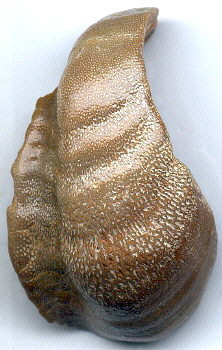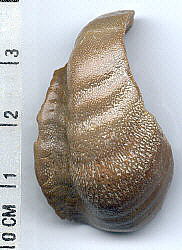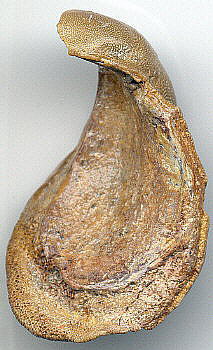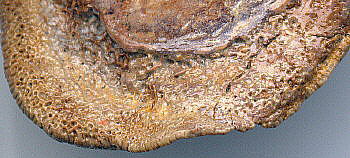Deltodus
sp.
Shark/Fish tooth
Mississippian
Salem Formation
St. Louis County, Missouri

This specimen, the Horn
Coral, and the Palaeacis
cuneiformis
were found less that 24 inches from each other.
Viewer Comments:
It is a Deltodus.
Nice specimen too. The old Illinois Geological
Survey Vol. VII, 1883 is a thick volume on the crusher teeth. This
is a bradyodont, probably more like a ratfish ancestor than a shark.
I collected many of these teeth in the old Biggsville, Illinois quarry
back in the early 1990's.
Bradyodonts are a group of chondrichthyians
(class
chondrichthyes) that are now classed with the holocephalians.
The holocephalians are related to the sharks but are not sharks
per-se. Both possess a cartilaginous skeleton and other features
(e.g. the reproductive system) that put them in the same class
(chondrichthyes). The holocephalians include the ratfishes and
chimaeras of today, odd-looking deep-water fishes. The term
bradyodont refers to the extinct holocephalians that possessed
hard enameloid plates in their mouth like the Deltodus tooth plate
in your photo.
Deltodus is the genus, so
you should list the tooth as Deltodus sp.
I'm pretty skeptical of species names for a lot of these Mississippian
bradyodonts since apparently nobody has done any detailed work
on these in about 120 years. Also what we have as genera are probably
form genera, that is different teeth bearing different genus names are
actually different mouth positions of the same animal in some cases.
The analogy is the group of form genera applied to different plant parts
in the Pennsylvanian plant faunas.
Gene Hartstein
It could be a Deltodus. Cumings & Beede illustrate D.
cinctus from the
Salem Ls. in Indiana. It is a curved shape with the growth ridges and
a flat platform on edge. See if you can find an illustration of that genus
somewhere.
Alan Goldstein
My first instinct is that it is a Deltodus
tooth. It's a beauty and out
of the matrix. Very unusual! I find those around here and sometimes
even out of the matrix but they are a different species. I do find them
identical to yours too, but none are out of the matrix.
Research material is hard to come by when
it comes to Paleozoic
sharks. An excellent source is the Handbook of Paleoichthyology -
Chondrichthyes I by R. Zangerl. While this is the best thing going
right now it does not cover much on the Paleozoic crusher tooth
sharks. I have never found much of anything on them.
Mark Palatas
Go-Back
Salem
Formation
Mississippian Fossils
of Missouri


